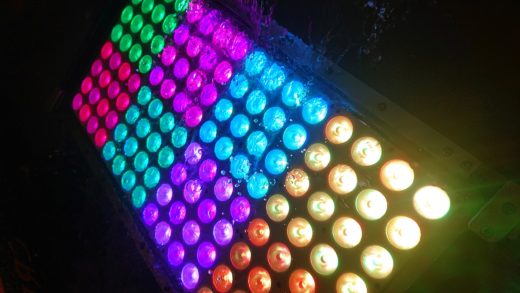
Recently, the world has become very excited about the technologies underlying colour mixing LED lights. Here’s why we shouldn’t.
It’s been a while since LED lights have generally been able to do what they’re intended to do, and do it pretty well. Even the quest for higher power is starting to encounter the reality that the bigger they get, the smaller the market is, particularly once power levels exceed the capacity of the 15-amp NEMA connectors common in American domesticity. Other problems are simply hard to solve: finding two lights both described as “daylight” from different manufacturers which actually, visually match is still more difficult than we’d all like it to be.
The sunlit uplands are perhaps not quite as evenly sunlit as they should be, even if modern full colour mixing lights can solve the problem given a bit of tweaking. Overall, though, after a decade of madcap innovation, things are perhaps calming down a little.
How colour mixing mixes colours
Consider the tendency for everyone to become concerned about the technology underlying colour mixing lights. No longer is it enough for lights to change colour; the manner in which they do so is now a point of contention. Lights based on red, green, blue and (one or two shades of) white LEDs now compete directly against those with red, green and blue plus amber, cyan, lime, and other things.
The problem is, that’s still too simple a way to describe the technology. Even if we have two lights using similar emitter configurations, there’s at least two major ways to create red, green and blue light with LEDs. Direct-emission types use different materials in the structure of the LED emitter itself to change colour; phosphor-converted types use a blue or violet emitter to excite a phosphor that emits light that isn’t blue or violet.
The advantage is a less saturated colour; a less spiky spectrum. The disadvantage is that phosphor conversion is an inefficient process, particularly in the red, which is why colour mixing lights using phosphor-converted red often have a large preponderance of red emitters. The choice is to trade off some efficiency for the broader, potentially kindlier spectrum of phosphor conversion, or to trade off some colour quality for output and efficiency. Welcome to the engineering compromise, and that’s just one specimen of the many engineering compromises involved in LED lights.
Whether or not a light is using PC emitters makes possibly at least as large a difference to its output and colour quality as the emitter configuration. For a start, there aren’t really PC green LEDs which are realistically available to people designing lights – well, there are, but the closest option is what’s usually called lime in the RGBACL combination. It’s a fairly unsaturated mint, and while lights have been made using that as the only green, the result has good colour quality in whites but can’t produce a deep emerald. Phosphor red is inefficient, and still less saturated than direct red, although to a great extent the broader spectrum is the point of phosphor conversion.
But do you want a nice powerful Star Trek alert red, or subtle tints of pink?
Subtle shades of white
Even if we’re only interested in white light, we’re likely to want to trim colour temperature and green-magenta bias. RGBW designs will tend to be more efficient than RGBACL simply because one blue emitter driving a white-emitting phosphor is likely to be more efficient than any combination of primary colours. If we want to trim plus-green, then the green emitter becomes key; a comparatively unsaturated phosphor lime emitter is a gentler way to add green than a highly saturated direct emission green.
There are certainly things RGBACL does very well – it can generally cover a broader range of colours, particularly in cyan. The colourspace of any RGB device (including LED lights, monitors, and film stocks) is often drawn on diagrams as a triangle, and the top point of that triangle is determined by which shade of green we’ve chosen to use. Mixing the green and blue primaries can probably only achieve a fairly subdued cyan, with a big space on the colour chart outside the area we can cover.
Adding a cyan emitter immediately means the system can achieve a greater range of turquoise-blue-green shades, although the amount of difference that makes depends to an extent on the colours the camera and display chain can handle. The same goes for adding other primaries, though cyan often makes the biggest visible difference.
We could go on like this all night. The answer to age-old enquiries about which is best comes down, as so often, to “it depends.” Perhaps the greatest expression of this truth is Panavision’s decision to build some of its colour mixing LED lights using RGBACL and white emitters, for the best of both worlds. The price-no-object approach, perhaps, but given most LED lights are limited by their thermal handling much more than the sheer number of emitters they have, it’s perhaps something we’ll see other people do as well.
Either way, objections to RGBACL or RGBW LED lights in the general case are likely to remain essentially religious, at least unless we’re doing something really, really specific with them.
